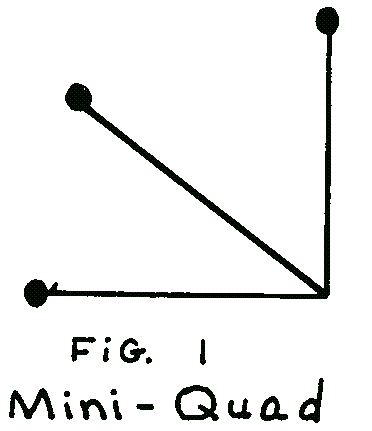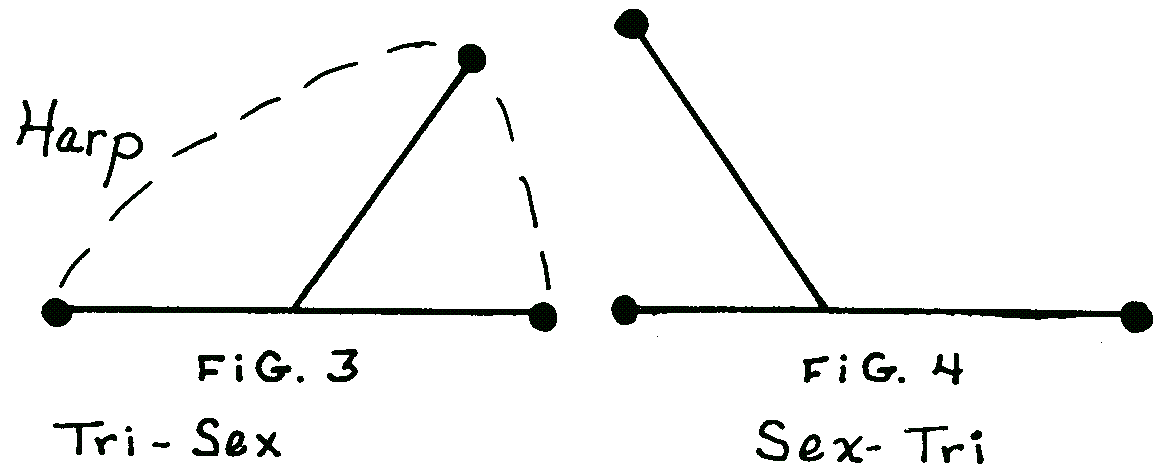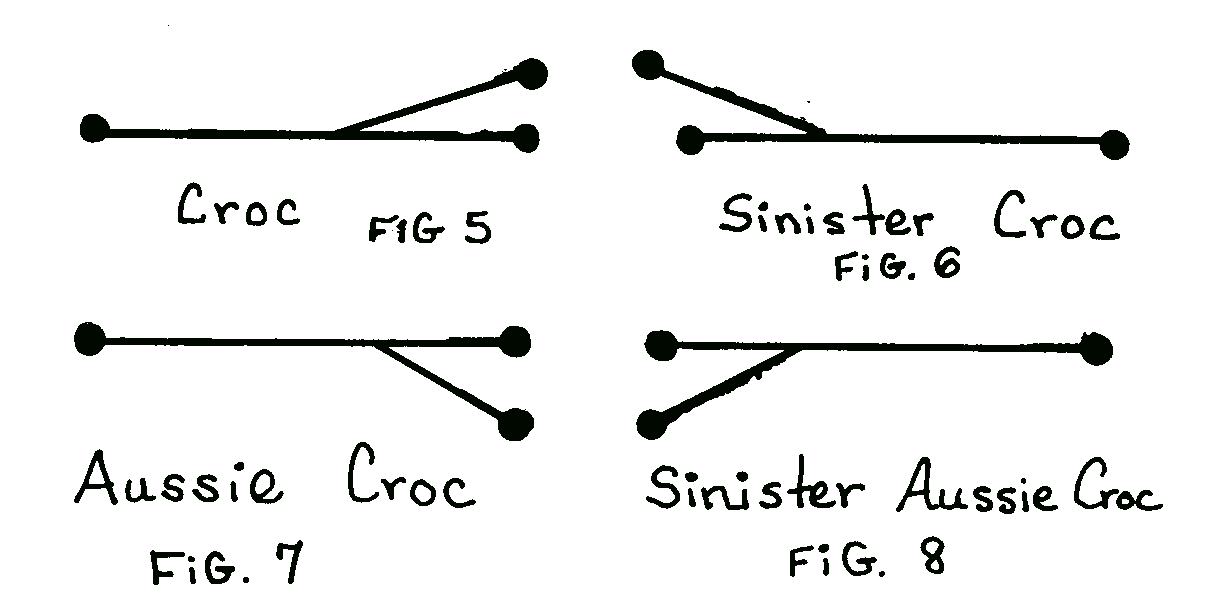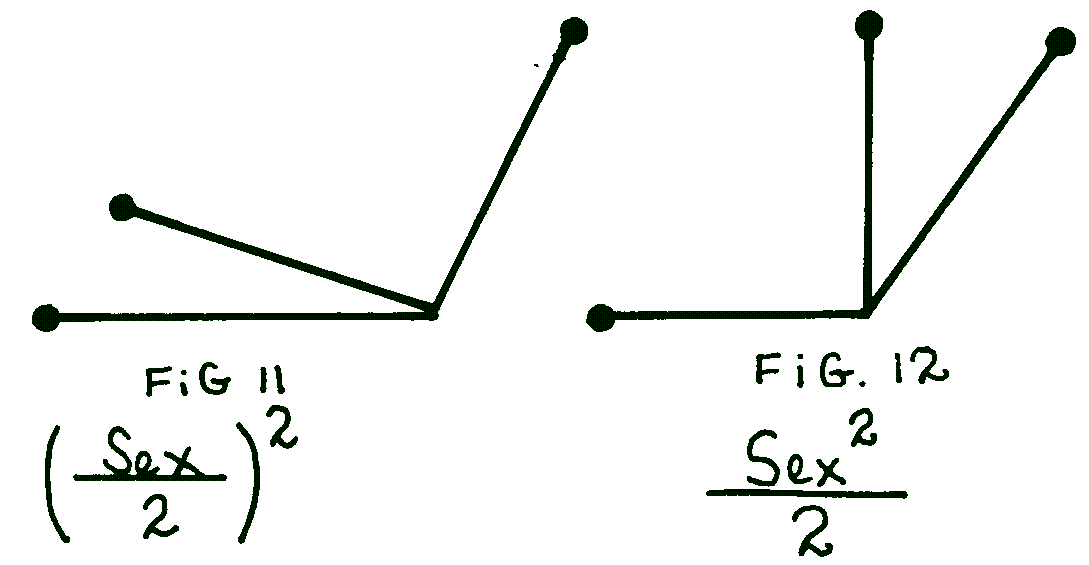Stellar Figures
Maritha Pottenger
Astrologers have long been aware of the interactive principle in horoscopes. That is, three planets all aspecting one another deserve more weight than three separate aspects which are not connected. However, the vocabulary to deal with the diverse forms present in astrology is still lacking. Certain configurations have been named, but others remain nameless.
Almost everyone knows, for example, that if two planets are sextile each other and both are quincunx a third planet, the configuration is known as a “yod.” However, what would you call the case when two planets are square one another, and a third planet in the middle semi-squares them both? (Obviously, this is an important midpoint situation. But what is its name?!) Therefore, to fill this glaring lack in the astrological literature, we are suggesting the following alternatives.
The above mentioned double semi- square within a square (see figure 1 below) shall be known as a “mini-quad.” By implication, it points to conflicts you must fight out on your own turf. You don’t get to wander far afield with these challenges. It’s right in your own back yard.

You can also have one planet which sesqui-squares both ends of a square (see figure 2 below). My preference is to call this a “maxi-quad,” but other possibilities which have been mentioned include a “V-square” or a “vuv.” This implies that such a configuration points to more extensive challenges, calling upon abilities from many sectors of our being.

Within a trine, you can have two sextiles. This form would obviously be a “sexi-trine” (which some may prefer to think of as a “sexy trine”). The ramifications for pleasurable activities are obvious. (Since this is a family magazine, no illustration of the sexy trine will appear.) One can also find a trine and sextile within an opposition. If the trine is earlier in the zodiac, we would call the three-planet configuration (see figure 3) a “tri- sex.” People with this combination are probably ever ready to play. The three- planet combinations with the sextile earlier in the zodiac (see figure 4) would be a “sex-tri.” The motto of people with this placement might be: “I tried it once and didn’t like it. Clearly these figures could have important implications for one’s love life. I anticipate research to investigate whether more fulfillment is associated with the “tri-sex” or the “sex-tri” configuration. An alternative name for this family of figures is the “harp.” Depending on the individual expression, we could expect people who make beautiful music or someone constantly harping on unpleasant themes.

When two planets form an opposition, a third planet can make a semi-sextile to one end of the opposition and a quincunx to the other end of the opposition. As is visually evident from figure 5 (below), this situation creates a family of crocs (short for crocodile). When the jaws are open to the right, we have your basic croc. With the jaws open to the left (figure 6), we have a sinister croc. When the croc goes down under (figure 7), we get an Aussie croc. And a croc going down under to the left (figure 8) is clearly a sinister Aussie croc. Depending on one’s viewpoint, we could also have an “upended croc,” a “croc doing a headstand” and numerous other variations. Like all crocodiles, these configurations require careful handling. People having several crocs in their charts are inclined to bite the hand that feeds them and may be noted for their toothy smiles and ready tears.

Within a quincunx, we can have a sextile and a square. Thus, our alternatives include (figure 9) sex squared (what fun!) or square sex (too conventional!—figure 10). Clearly, you want to be sure your style is compatible with that of your partner.

Within a trine, you can have a semi-sextile and a square. In one case, we would halve the sex available and square our result (figure 11). In the second case, we would square the sex available and then halve it (figure 12). If you value quantity, we must recommend the latter configuration.

Two planets within an opposition make sesqui- and semi-squares to a third planet. When the sesqui-square is first (figure 13), the configuration is a “squeem.” If the semi-square is first (figure 14), the figure is a sinister squeem. People with many “squeems” in their charts tend to live with queasy stomachs.

An opposition also contains three sextiles (figure 15), creating the “ironing board” figure. This signature implies a strong sense of style and the ability to live a wrinkle-free existence. When a trine and two semi- sextiles combine to form an opposition, we have “the bird” of figure 16. This symbol of “winged victory” is a clear indicator of good triumphing over evil. It also indicates someone who believes in the old proverb: “S/he who fights and runs away lives to fight another day.”

The above is by no means a complete summary of the many figures available to us. Readers are invited to submit additional possibilities with names and suggested interpretations. We will be happy to publish contributions.